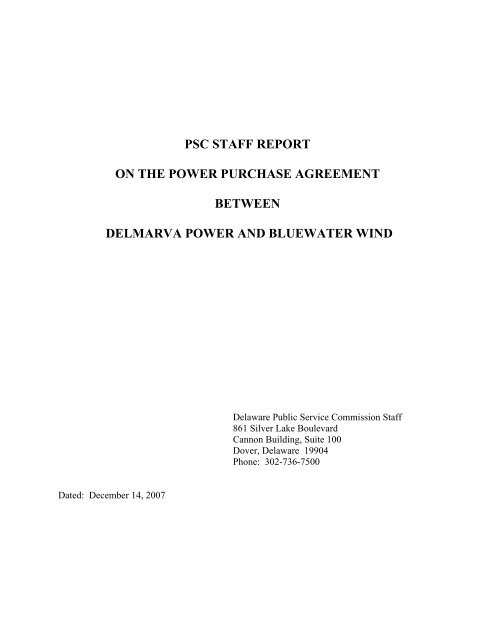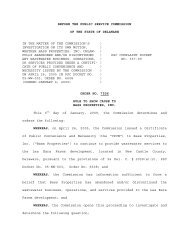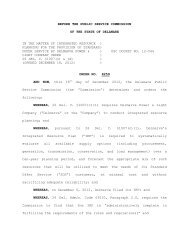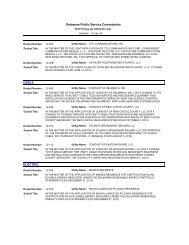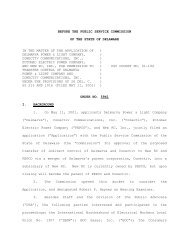PSC STAFF REPORT ON THE POWER PURCHASE AGREEMENT ...
PSC STAFF REPORT ON THE POWER PURCHASE AGREEMENT ...
PSC STAFF REPORT ON THE POWER PURCHASE AGREEMENT ...
You also want an ePaper? Increase the reach of your titles
YUMPU automatically turns print PDFs into web optimized ePapers that Google loves.
<strong>PSC</strong> <strong>STAFF</strong> <strong>REPORT</strong><br />
<strong>ON</strong> <strong>THE</strong> <strong>POWER</strong> <strong>PURCHASE</strong> <strong>AGREEMENT</strong><br />
BETWEEN<br />
DELMARVA <strong>POWER</strong> AND BLUEWATER WIND<br />
Delaware Public Service Commission Staff<br />
861 Silver Lake Boulevard<br />
Cannon Building, Suite 100<br />
Dover, Delaware 19904<br />
Phone: 302-736-7500<br />
Dated: December 14, 2007
I. Background.<br />
In March 2006, the Delaware General Assembly introduced House Bill No. 6 1 (“the<br />
EURCSA”) in response to extensive consumer outrage occasioned by the announcement of<br />
imminent and significant rate increases resulting from the higher cost of fuel used to generate<br />
electricity and the shift to PJM market-based prices. The cumulative effect of these increases<br />
was felt by Delmarva Power & Light Company (“Delmarva”) customers at one time due to the<br />
expiration of rate freezes established with deregulation of Delaware’s electric supply industry.<br />
The purpose of the EURCSA was to spread out the impact of the rate increases and enable<br />
certain state agencies to explore alternative options of SOS 2 procurement at reasonable and<br />
stable prices. The legislation specifically required Delmarva to develop an Integrated Resource<br />
Plan (“IRP”) and “investigate all possible opportunities for a more diverse supply at the lowest<br />
reasonable cost.” 3<br />
On or before August 1, 2006, as part of its IRP, Delmarva was required to file<br />
a proposal to obtain long-term contracts, including a proposed Request for Proposal (“RFP”) for<br />
the construction of new generation resources within Delaware to serve its SOS customers.<br />
The EURCSA specifically directed the Delaware Public Service Commission (“the<br />
Commission”), in conjunction with the Delaware Energy Office, the Controller General, and the<br />
Director of the Office of Management and Budget (collectively “the State Agencies”), to<br />
evaluate the proposals received pursuant to the RFP and “determine to approve one or more of<br />
such proposals that result in the greatest long-term system benefits … in the most cost-effective<br />
manner.” 4<br />
The State Agencies retained an Independent Consultant (“the IC”), a consulting team<br />
1 HB 6 is codified in the Electric Utility Retail Customer Supply Act of 2006, 26 Del. C. §§ 1001-1019.<br />
2 SOS refers to Delmarva customers who do not receive their energy supply from a third-party electric provider. 26<br />
Del. C. § 1001(18).<br />
3 26 Del. C. § 1007(c)(1)b.<br />
4 Id. at § 1007(d)(3).
led by New Energy Opportunities, Inc., to oversee development of the RFP and assist the State<br />
Agencies during the bid evaluation.<br />
Following the EURCSA’s mandate, Delmarva filed its proposed RFP on August 1, 2006.<br />
In October 2006, the Commission and Energy Office adopted a “big funnel” approach and<br />
developed the criteria to be included in Delmarva’s RFP that would guide the evaluation of the<br />
potential bids. On December 21, 2006, Conectiv Energy Supply, Inc. (“Conectiv”) submitted a<br />
primary and alternate bid for a 180 MW combined cycle gas turbine (“CCGT”) located at its Hay<br />
Road site in Edgemoor, Delaware. The following day, Bluewater Wind LLC (“Bluewater”)<br />
submitted twelve variations of a bid proposal that included both 20- and 25- year terms and (1) a<br />
600 MW capacity plant with a 400 MW energy limit or (2) a sale of two-thirds of the energy<br />
from a 600 MW plant. That same day, NRG Energy Inc. (“NRG”) submitted a proposal to sell<br />
energy and unforced capacity credits from 400 MW of a 600 MW coal-fired integrated<br />
gasification combined cycle (“IGCC”) facility to be constructed at its Indian River site.<br />
On February 21, 2007, Delmarva and the IC filed bid evaluation reports. Both Delmarva<br />
and the IC ranked the bids as follows: (1) Conectiv; (2) Bluewater; and (3) NRG. Delmarva<br />
concluded that none of the bids achieved the EURCSA’s objective because each bid was above<br />
the market forecast and produced minimal price stability. Delmarva asserted that the EURCSA’s<br />
objectives could be satisfied with demand side management (“DSM”) programs and energy<br />
purchases from the regional market. The IC recommended deferring a financial decision on the<br />
proposals pending Staff’s analysis of reliability and economics. The IC also suggested<br />
employing a market test to evaluate other regional options.<br />
On May 3, 2007, Staff issued the “<strong>PSC</strong> Staff Review and Recommendations on<br />
Generation Bid Proposals,” (“Generation Bid Report”) in which it recommended that the State<br />
2
Agencies adopt a portfolio approach to energy planning that would involve the addition of new<br />
generation assets in southern Delaware, development of DSM and energy efficiency programs,<br />
renewable distributed generation, short- and long-term bilateral contracts, and market purchases.<br />
With respect to the generation bids, Staff recommended that the State Agencies direct Delmarva<br />
to negotiate with both Conectiv and Bluewater for a hybrid energy supply that would combine a<br />
200-300 MW offshore wind farm with a 150-200 MW synchronous condenser CCGT in Sussex<br />
County.<br />
On May 22, 2007, by Order No. 7199, the State Agencies accepted Staff’s proposed<br />
energy supply portfolio and directed Delmarva to negotiate in good faith with Bluewater for a<br />
long-term power purchase agreement (“PPA”) for the provision of offshore wind power. The<br />
Order further instructed Delmarva to negotiate independently with both Conectiv and NRG to<br />
provide any necessary backup firm power to ensure reliability when wind power is not available<br />
and directed that the negotiations for the backup power be conducted at the same time as the<br />
Bluewater-Delmarva negotiations. The Order provided that the negotiations conclude within a<br />
60-day time frame, but the State Agencies indicated their flexibility in extending this deadline, if<br />
necessary, to the extent that there was continuing progress in the PPA negotiations. The State<br />
Agencies also directed the Staff to retain a third party to oversee the progress of the negotiations<br />
and report back periodically to the State Agencies regarding the status of the negotiations and the<br />
efforts of all parties to negotiate the PPAs in good faith as well as to conform with the EURCSA.<br />
Staff hired Lawrence A. Hamermesh, Esquire, to perform this oversight function as directed by<br />
the State Agencies.<br />
During the summer months of 2007, the parties engaged in PPA negotiations and<br />
provided a status report to the State Agencies on August 7, 2007. Aspiring for completed PPAs<br />
3
y the end of 2007, the State Agencies directed Delmarva to circulate detailed Term Sheets<br />
outlining the material terms of arrangements with Bluewater and the backup firm providers by<br />
September 14, 2007. 5 Delmarva filed all three Term Sheets as directed on September 14, 2007.<br />
On October 29, 2007, Staff issued the “<strong>PSC</strong> Staff Report On the Term Sheets for<br />
Proposed Power Sales to Delmarva Power” (“the Term Sheet Report”), in which it recommended<br />
that the State Agencies deny approval of all three Term Sheets, consider the Bluewater proposal<br />
under specific parameters that would address the concerns raised by Staff, and continue<br />
exploration of portfolio energy supply options in the ongoing IRP process. Staff determined that<br />
Bluewater’s revised proposal in the Term Sheet did not achieve the greatest long-term system<br />
benefits in the most cost-effective manner in light of the significant risk and cost imposed on the<br />
SOS ratepayers by the asymmetrical pricing escalator combined with the delay in the timing of<br />
the revised proposal. In response to the Term Sheet Report, Bluewater withdrew the pricing<br />
escalator from its proposal on November 6, 2007.<br />
Following extensive comment from the participants and the public regarding the merits of<br />
the Term Sheets, the State Agencies directed Bluewater and Delmarva to continue negotiations<br />
for a finalized contract for the procurement of offshore wind power in Delaware. 6<br />
The State<br />
Agencies limited the scope of the Bluewater-Delmarva negotiations to issues regarding price,<br />
non-conforming terms, and disputed contract terms. The State Agencies further empowered Mr.<br />
Hamermesh to resolve all outstanding issues in the proposed contract that would be brought<br />
before the State Agencies on December 18, 2007 for their final decision on the offshore wind<br />
proposal. This is Staff’s report regarding the State Agencies’ options with respect to the<br />
finalized Bluewater-Delmarva PPA submitted on December 10, 2007.<br />
5 See <strong>PSC</strong> Order No. 7277 (September 4, 2007).<br />
6 See <strong>PSC</strong> Order No. 7328 (December 4, 2007).<br />
4
II.<br />
Economic Analysis of the Bluewater-Delmarva PPA.<br />
The continued negotiations between Bluewater and Delmarva produced less expensive<br />
pricing provisions for Delmarva’s purchase of energy. In a report issued on December 13, 2007,<br />
the IC determined that Bluewater reduced its energy and capacity price by approximately 5%<br />
from the corresponding pricing provisions in the Term Sheet. In the Term Sheet, Bluewater<br />
proposed an initial (2007) energy rate of $105.90/MWh (i.e. 10.59¢ per kWh). The finalized<br />
PPA reduces the energy rate to $98.93/MWh (i.e. 9.893¢ per kWh). With respect to Bluewater’s<br />
sale of capacity and renewable energy credits (“REC”), the capacity payment rate increases from<br />
the $65.23/kW-year proposed in the Term Sheet to $70.23/kW-year while the REC payment rate<br />
remains at $19.75 per REC as proposed under the Term Sheet. Because Bluewater had<br />
previously withdrawn the asymmetrical commodities and currency pricing escalator from its<br />
proposal, the energy, capacity, and REC payment rates are not subject to adjustment based on<br />
changes in construction-related commodities indices and currency exchange rates. However, all<br />
three payment rates are subject to an annual 2.5% inflation pricing escalator pursuant to the final<br />
PPA.<br />
Pursuant to Order No. 7328, the IC identified a common set of assumptions that would be<br />
utilized in the economic analysis of the finalized PPA. Following the State Agencies directive,<br />
Delmarva’s consultants, Bluewater’s consultant and the IC (collectively “the consultants”)<br />
agreed to evaluate the price impact on SOS customers over the term of the PPA in real levelized<br />
2007 dollars where the impact would be expressed in dollars per MWh. Because the average<br />
residential and small commercial (“RSCI”) SOS customer consumes approximately 1,000 kWh<br />
per month, the dollars per MWh figure translates to the monthly impact on a typical RSCI<br />
customer’s electric bill. The consultants converted the rate impact from nominal dollars (i.e.<br />
5
value that is not adjusted for inflation) utilizing a 2.5% inflation rate and a 6.3% real discount<br />
rate. The consultants further agreed to express annual (i.e. year-by-year) rate impacts in both<br />
real levelized 2007 dollars and nominal dollars. 7<br />
The IC concluded that the continued negotiations yielded a more attractive project from<br />
an economic standpoint – the offshore wind facility proposed under the PPA is less expensive<br />
than the project outlined in the Bluewater Term Sheet, even without application of the<br />
commodities and currency pricing escalator. After application of the common metrics, the IC<br />
concluded that the Bluewater PPA proposal, although less expensive than the Term Sheet<br />
proposal, continues to have the potential to increase SOS customer supply rates above forecasted<br />
market prices. As depicted in Table 1, below, the overall rate impact to RSCI SOS customers is<br />
projected to be $6.46/MWh as a stand-alone project, and declines to $5.15/MWh in combination<br />
with Conectiv’s proposal. 8<br />
Table 1: Comparison to Previous Bluewater Proposals<br />
Old BW (2006) New BW-Nov New BW-Dec<br />
2007(No Adj) 2007<br />
Contracted Annual Energy (GWh) 1,588 1,106 1,106<br />
Percentage of 2014 SOS Load 42% 29% 29%<br />
Annual Avg. REC Purchases (GWh) 170 174 1,106<br />
Real Levelized SOS Cost Impact<br />
with 25% Risk Factor for Imputed<br />
Debt ($/MWh)<br />
$6.26 $8.06 $6.46<br />
Moreover, implementation of a non-bypassable charge, as authorized under 26 Del. C. § 1010(c),<br />
that would spread the cost across all Delmarva distribution customers, reduces the rate impact by<br />
7 See “IC Assessment of Power Purchase Agreement Between Delmarva Power and Bluewater Wind Delaware<br />
LLC” (the “IC PPA Assessment”) at 11-17 for a detailed discussion of the assumptions employed by the IC and the<br />
results of sensitivity analyses.<br />
8 The Bluewater/NRG hybrid proposal (NRG’s original proposal) would have negative value increasing the price<br />
impact to over $7/MWh.<br />
6
nearly 50 percent to $3.37/MWh and $2.69/MWh for the Bluewater PPA as a stand-alone and<br />
the Bluewater/Conectiv hybrid, respectively. Allocation of cost to all electricity consumers in<br />
Delaware – pursuant to new legislation – further diminishes the price impact to $2.24/MWh and<br />
$1.78/MWh for the Bluewater stand-alone and Bluewater/Conectiv hybrid, respectively. A<br />
comparison of the price impact under alternative cost allocation measures is depicted in Table 2,<br />
below:<br />
Table 2: Revised Bluewater Proposal with Backup PPAs and Different Load Impacts<br />
SOS Load Impact<br />
(2007$/MWh)<br />
Delmarva Load Impact<br />
(2007$/MWh)<br />
Delaware State Load<br />
Impact (2007$/MWh)<br />
BW <strong>ON</strong>LY $6.46 $3.37 $2.28<br />
BW+NRG $7.35 $3.83 $2.60<br />
BW+CESI $5.15 $2.69 $1.83<br />
In light of the potential to allocate net costs against a larger customer base, the IC concluded that<br />
the Bluewater PPA proposal presents an opportunity to reduce the rate impact over the term of<br />
the PPA to approximately $2-3/MWh. With regard to the year-by-year impact of the Bluewater<br />
PPA proposal, the initial rate impact projections are higher – in the range of $13-14/MWh – but<br />
steadily decrease each year until the price impact falls below market forecast approximately halfway<br />
through the contract term. 9<br />
II. Summary of Risks and Benefits Associated with the Bluewater-Delmarva PPA. 10<br />
The State Agencies are charged with balancing the attendant risks and benefits associated<br />
with the execution of the finalized Bluewater-Delmarva PPA and determining whether<br />
Bluewater’s proposal fulfills the mandates of the EURCSA. The EURCSA seeks to ensure that<br />
9 See IC PPA Assessment at 7-9 for a detailed analysis of the year-by-year rate impact.<br />
10 For a detailed analysis of the disputed commercial contract terms and the resolutions thereof, please see<br />
“Resolution and Commentary on Disputed Issues in the Delmarva/Bluewater Power Purchase Agreement” filed by<br />
Mr. Hamermesh on December 12, 2007.<br />
7
Delaware’s future energy portfolio is comprised of dependable energy sources, a reliable power<br />
system, and reasonable, stable energy prices.<br />
The EURCSA confers authority on the State<br />
Agencies to approve a proposal that results in the greatest long-term system benefits in the most<br />
cost-effective manner. 11<br />
The EURCSA specifically identified the following long-term system<br />
benefits:<br />
(1) utilization of new or innovative baseload technologies;<br />
(2) provision of long-term environmental benefits to the state;<br />
(3) utilization of existing fuel and transmission infrastructure;<br />
(4) promotion of fuel diversity;<br />
(5) support or improvement of reliability; and<br />
(6) utilization of existing brownfield or industrial sites. 12<br />
Following the deregulation of Delaware’s electric industry in 1999, very little new<br />
generation was built due to limitations on fuel availability and transportation to the Delmarva<br />
Peninsula, environmental and zoning constraints, and the rural nature of the load. In light of the<br />
scarcity of new generation and the rising demand for energy in Delaware, electricity prices have<br />
risen steadily. In its recommendation to the State Agencies regarding evaluation of the<br />
generation bid proposals, Staff recognized Delaware’s need for additional new generation to<br />
avoid the enormous risks and uncertainties associated with future shutdowns of antiquated,<br />
inefficient generating units, which comprise the majority of Delaware’s electricity sources. 13<br />
Delaware’s limited generation resources exposes its energy users to a high level of market power<br />
in which generators have the ability to significantly influence market prices. 14<br />
Moreover, Staff<br />
11 26 Del. C. § 1007(d)(3).<br />
12 See id. at § 1007(d)(1)a.-f.<br />
13 See Generation Bid Report at 68.<br />
14 Id. at 52-53.<br />
8
stressed the significant risk of reliance on PJM’s Reliability Pricing Model (“RPM”) that has<br />
resulted in a dramatic, 1,277 percent rise in capacity charges since 2006. 15<br />
Delaware’s unique<br />
energy needs require the State Agencies to weigh all of the benefits outlined in the EURCSA<br />
rather than make price the sole consideration.<br />
Bluewater’s PPA proposal presents a number of long-term system benefits provided for<br />
under the EURCSA. First and foremost, price stability – the primary goal of the EURCSA – is a<br />
principal attribute of the Bluewater-Delmarva PPA. The Bluewater-Delmarva PPA establishes<br />
new, innovative generation that promotes fuel diversity in Delaware. The delivered cost of fuel<br />
to power plants throughout PJM is the single largest determinant of electric energy prices.<br />
Natural gas is the primary fuel of critical relevance in setting energy prices in the PJM market.<br />
The long-term outlook for natural gas prices reflects robust demand and increased reliance on<br />
imported natural gas supplies from the Middle East, the Former Soviet Union, and Africa for<br />
which the U.S. must compete with Asia and Europe. Accordingly, over the long-term, natural<br />
gas prices are expected to remain high by historic standards and also extremely volatile.<br />
Moreover, as electricity consumers across the nation have painfully learned, the thin margin<br />
between the U.S. supply and demand can have disastrous effects on price in the event of natural<br />
disasters or pipeline disturbances. The Bluewater-Delmarva PPA would reduce Delaware’s<br />
reliance on wholesale market prices dictated by natural gas prices, and accordingly, would<br />
dampen SOS ratepayers’ exposure to price volatility. Delaware’s captivity to the volatility of the<br />
PJM market and its RPM rules is the precise ground for Staff’s May 3, 2007 recommendation<br />
that Delaware take control of its energy future through a diverse energy supply portfolio. In<br />
addition to integrating appropriately into the energy supply portfolio, innovative offshore wind<br />
15 Id.<br />
9
energy technology 16<br />
reduces reliance on fossil fuels that emit carbon dioxide and other<br />
greenhouse gases. The production of carbon free energy is undoubtedly an attractive feature of<br />
the PPA, particularly in light of federal greenhouse gas regulations that are expected to be<br />
implemented prior to the project’s in-service date, and the positive health impacts in Delaware<br />
and the surrounding region associated with clean energy.<br />
Second, the production of clean energy from Bluewater’s proposed wind facility provides<br />
long-term environmental benefits to Delaware. As many of the proponents of the wind project<br />
have reiterated throughout the RFP proceeding, the forging of offshore wind power in Delaware<br />
– the first of such facilities in the United States – would unquestionably be a major contribution<br />
to addressing climate change. At the November 20, 2007 hearing, Former Governor Russell<br />
Peterson explained that the nation is engaging in a transition toward green energy in response to<br />
global warming. On a national level, several state leaders, including Montana’s governor, have<br />
taken steps to promote renewable energy and the Court of Appeals for the Ninth Circuit recently<br />
rejected a fuel standard established by the Bush Administration for failure to adequately reduce<br />
greenhouse gas emissions. Because of the Bush Administration’s failure to initiate a federal<br />
program, the State of Delaware – through the leadership of Governor Minner – has entered into a<br />
Memorandum of Understanding with nine other Mid-Atlantic and Northeastern states to reduce<br />
each state’s carbon footprint, through the Regional Greenhouse Gas Initiative (“RGGI”).<br />
Specifically, RGGI targets a reduction in carbon emissions from fossil fuel generating plants in<br />
the participating states. In Delaware, on July 24, 2007, the General Assembly doubled the<br />
Renewable Energy Portfolio Standard (“RPS”) percentage requirement for retail electric<br />
16 The PPA will also create new, construction-related Delaware jobs and will have some positive impact on<br />
economic development in the State.<br />
10
suppliers to 20% by 2019, which includes 2.005% for solar photovoltaics (“PV”). 17<br />
As a result<br />
of this amendment, Delaware has one of the most aggressive RPS requirements in the United<br />
States. By comparison, Maryland’s and Pennsylvania’s RPS are 7.5% by 2019 18 and 8-10% by<br />
2020, 19 respectively. New Jersey 20 – a leader in the promotion of green energy – also has an<br />
aggressive RPS percentage requirement of 22.5% by 2021, which includes 7.5% for solar PV. 21<br />
Execution of the Bluewater-Delmarva PPA will allow Delmarva to fully satisfy Delaware’s RPS<br />
not related to solar PV.<br />
Finally, the Delmarva-Bluewater PPA, in conjunction with the backup component of the<br />
hybrid model, will have a positive impact on system reliability. In the Term Sheet Report, Staff<br />
reiterated its belief that a new generation resource located in Southern Delaware is needed in<br />
light of the planned retirements of two Indian River generating facilities. Pursuant to the PPA,<br />
the proposed wind facility would be located approximately 11.5 miles off the coast of Rehoboth<br />
Beach and would interconnect with the power grid at the Indian River Interconnection Point.<br />
Accordingly, the PPA injects new generation into the precise site where Staff has expressed<br />
significant concerns regarding reliability. While wind is an intermittent resource, when<br />
combined with Staff’s recommendation for firming capacity in the hybrid model, Staff asserts<br />
that the reliability of energy delivery to the fastest growing segment in Delaware will be<br />
17 “An Act to Amend the Delaware Code to Increase the Renewable Energy Portfolio Standard.” See 76 Del. Laws<br />
ch. 165 sections 1-9 (July 24, 2007).<br />
18 See Md. Code Ann. Public Utility Companies § 7-701(i).<br />
19 Pennsylvania’s RPS provides a range that varies based on the renewable energy source employed. See 73 P.S. §§<br />
1648.1-1648.8.<br />
20 Notably, on October 4, 2007, The New Jersey Board of Public Utilities (“NJBPU”) unanimously approved an<br />
offshore wind competitive grant solicitation with up to $19 million in funding to support the financing and<br />
development of an offshore wind project with an aggregate capacity of up to 350 MW. NJBPU President Jeanne M.<br />
Fox commended Governor Corzine on his leadership in exploring offshore wind as “a clean renewable resource that<br />
has the potential to provide greater fuel diversity for New Jersey, while simultaneously fighting global warming that<br />
threatens our New Jersey shoreline.” See October 4, 2007 Press Release available at<br />
http://www.state.nj.us/bpu/newsroom/news/pdf/20071004.pdf.<br />
21 See N.J.S.A. § 48:3-49, et seq.<br />
11
addressed for the future. Moreover, the Bluewater PPA proposal provides for a more favorable<br />
delivery point on the Delmarva transmission system. By requiring Bluewater to provide capacity<br />
that clears PJM’s RPM capacity auctions, the PPA also reduces the risk to Delmarva – and its<br />
SOS customers – associated with the RPM auctions.<br />
The over-market projected cost associated with Bluewater’s proposal outlined in the final<br />
PPA likely poses the most risk to Delmarva’s SOS ratepayers. As the IC observed, the<br />
Bluewater PPA proposal is less expensive than its prior proposal under the Term Sheet, but it<br />
continues to potentially impose a higher cost on the SOS ratepayers over the term of the contract<br />
compared to forecasted PJM market prices. The IC concluded that execution of the PPA will<br />
result in a price impact of $6.46/MWh per month per customer compared to $8.06/MWh 22 and<br />
$6.23/MWh for Bluewater’s Term Sheet and original bid proposal, respectively. The long lead<br />
time between execution of the PPA and production of energy from the wind facility, which could<br />
be as long as seven years, poses some additional price risk. First, this delay poses an opportunity<br />
cost risk representing the time lost – up to seven or eight years – in addressing Delaware’s<br />
energy needs in the event that the Bluewater project does not achieve commercial operation.<br />
Moreover, the delay, combined with the long-term nature of the PPA, deprives SOS customers<br />
the benefit of advances in renewable energy technology. However, this potential risk is<br />
mitigated to some degree by the security and delay damages provisions in the PPA. Staff<br />
believes that the original procurement approach that would allocate the entire expense of energy,<br />
capacity, and RECs completely to Delmarva’s RSCI SOS ratepayers who consume<br />
22 The IC arrived at this rate impact figure without applying the price adjustment for changes in construction-related<br />
commodities indices and the currency exchange rates because Bluewater withdrew this pricing escalator on<br />
November 6, 2007.<br />
12
approximately 35% of the electricity in Delaware, is inequitable and if the PPA is approved,<br />
should be addressed expeditiously.<br />
With respect to Delmarva’s purchase of the full amount of RECs associated with the<br />
energy purchased from Bluewater – a significant increase from the 175,000 limit proposed under<br />
the Term Sheet – the uncertain nature of the market exposes SOS customers to some additional<br />
price risk, albeit that the potential also exists for the REC contract price to fall below market<br />
price or have a positive economic impact. The IC concluded that Bluewater’s sale of RECs most<br />
likely provides neither additional net cost nor net benefit to Delmarva’s ratepayers based on REC<br />
forward market prices and the potential for the infusion of a large number of RECs to dampen<br />
REC market prices in the future.<br />
It is true that the intermittent nature of wind increases the risk that Delmarva will resort to<br />
energy purchases from the spot market, thereby reducing some of the price stability benefit<br />
generated from Bluewater’s project. PJM penalties and charges related to negative locational<br />
marginal price (“LMP”) caused by differences in the quantities of energy scheduled day-ahead<br />
with PJM versus the energy actually delivered from Bluewater’s wind facility (due to the<br />
inherent uncertainties associated with an intermittent resource, which is offset by a cap on<br />
required energy purchases) also adds some price risk to Delmarva’s SOS ratepayers. However,<br />
Staff believes that potential exposure to this “balancing” risk is minimal on a long-term basis.<br />
In addition to price risk, several factors create some uncertainty regarding project<br />
viability. First, the PPA confers termination rights on Bluewater if the pending Minerals<br />
Management Service (“MMS”) regulations governing the permitting and siting of offshore wind<br />
farms are not published by November 30, 2010, or render Bluewater’s project economically nonviable.<br />
Second, Bluewater will not be eligible for a federal production tax credit (“PTC”) –<br />
13
currently, in the amount of $19/MWh – for electricity produced from wind-powered electric<br />
generation facilities unless the PTC is reauthorized to apply to wind projects that are built in the<br />
timeframe of the project’s expected construction period. Section 5.7 of the PPA does not allow<br />
Bluewater to capture true-up for elimination or modification of the PTC, but rather authorizes<br />
Bluewater to terminate the contract, upon relinquishment of its Development Period Security as<br />
liquidated damages, in the event that the PTC is not extended or is materially adversely modified<br />
with respect to the wind project.<br />
Finally, employment of existing technology in a new<br />
geographic area poses some operational risk and the possibility for delay. If the Bluewater<br />
project is terminated or downsized, then Delmarva’s SOS customers could be exposed to the<br />
volatility in gas and spot market prices absent an opportunity to obtain another stable priced<br />
energy resource through a long-term contract or a self-build option. The State Agencies must<br />
balance the foregoing benefits and risks, within the conceptual framework of the EURCSA, and<br />
determine whether the offshore wind facility, as proposed under the PPA, is in the public<br />
interest.<br />
IV.<br />
Options Available to the State Agencies.<br />
The fundamental question before the State Agencies is whether the benefit of<br />
implementing a large, landmark offshore wind resource into Delaware’s energy portfolio<br />
outweighs the attendant additional cost, lead time, and uncertainty compared to a purchase of<br />
renewable energy from an onshore regional (i.e. out-of-state) wind resource that may provide<br />
less attractive long-term system benefits. The State Agencies have several options available for<br />
consideration to address this issue. Staff has identified three distinct approaches that the State<br />
Agencies may pursue.<br />
14
• First, the State Agencies could approve or deny the Bluewater-Delmarva PPA based<br />
solely on the existing terms and conditions outlined in the contract. Notably, the<br />
opposition of any one of the State Agencies will prevent approval of the PPA.<br />
• Second, the State Agencies could approve the Bluewater-Delmarva PPA with additional<br />
conditions not included in the body of the contract.<br />
• Third, the State Agencies could deny approval of the PPA, but the Commission could<br />
review Bluewater’s offshore wind proposal and other renewable energy supply options in<br />
the IRP process.<br />
All three options available to the State Agencies have implications on the following five policy<br />
considerations:<br />
• Ratepayer equity and cost allocation;<br />
• Potential opportunity cost;<br />
• Price stability;<br />
• Climate change; and<br />
• Cost effectiveness compared to other renewable energy sources.<br />
Each of the options and the corresponding positive and/or negative effects on the foregoing<br />
policy implications are discussed in turn.<br />
1. Denial.<br />
Denial of the PPA by the State Agencies places decisions related to Delaware’s energy<br />
needs back in the control of the PJM market. Pursuit of this option requires reliance on the PJM<br />
market and further precludes the opportunity to fulfill the central objective of the EURCSA, i.e.<br />
to foster long-term price stability for SOS customers. As discussed above, natural gas prices –<br />
the primary driver of PJM market energy prices – are expected to remain high by historic<br />
standards and extremely volatile. A decision not to execute the PPA fails to take advantage of<br />
the wind project’s hedge to long-term energy market price risk. Finally, denial of the PPA<br />
15
ypasses an opportunity to initiate a significant step in addressing climate change and procuring<br />
long-term environmental benefits for Delaware.<br />
On the other hand, denial of the PPA avoids the price, development, and regulatory risk<br />
associated with a large-scale offshore wind facility. Denial of the PPA further avoids concern<br />
over ratepayer equity because there is no cost to spread out over various classes of electricity<br />
consumers in Delaware. Because this option does not fulfill the climate change and price<br />
stability policy considerations, it would be appropriate where viable in-state 23 renewable energy<br />
alternatives, such as onshore wind, are available to accomplish the same long-term system<br />
benefits provided by an offshore wind facility.<br />
2. Approval.<br />
a. Exclusively on the terms outlined in the PPA.<br />
Although Bluewater’s PPA proposal includes an above-market price, the price is<br />
predictable and may become even more predictable when combined with a firming power<br />
resource. An offshore wind facility provides a hedge against the volatility in the gas and spot<br />
market caused by rising fuel prices. The Bluewater PPA proposal will be a major step towards<br />
releasing Delaware’s electric consumers from captivity to the PJM market that has caused<br />
dramatic spikes in both capacity charges and electricity prices since initiation of the RFP<br />
process.<br />
Accordingly, execution of Bluewater’s PPA will satisfy the primary policy<br />
consideration of the EURCSA – promotion of price stability for SOS customers.<br />
Approval of the PPA will pave the way for development of one of the largest carbonfree<br />
electric generating resources in North America. In light of the global concern regarding<br />
carbon dioxide emissions, this development would undoubtedly be a major step in addressing<br />
23 Notably, the EURCSA expressly precludes consideration of out-of-state generation resources in the RFP process.<br />
See 26 Del. C. § 1007(d).<br />
16
climate change. As described earlier, climate change has been considered the greatest global<br />
environmental challenge of this century. The PPA will further allow Delmarva to fulfill<br />
Delaware’s aggressive RPS standard and eliminate SOS customers’ exposure to costly REC<br />
compliance payments. Moreover, the Bluewater project’s production of carbon free energy will<br />
provide positive health impacts in Delaware and the PJM region.<br />
In addition to price stability and long-term system benefits, the EURCSA also mandates<br />
that any proposed new source of generation in Delaware must be achieved in the most costeffective<br />
manner. With regard to the cost-effectiveness policy consideration, the price of<br />
offshore wind resources is currently higher than such prices for the alternative energy resources<br />
such as onshore wind. On the other hand, the IC observed that regional onshore wind resources<br />
will ultimately be developed with less attractive sites available for new construction resulting in<br />
higher PPA costs and the U.S. will transition to development of offshore resources comparable to<br />
those already in operation in Europe.<br />
Notwithstanding the IC’s observation about future onshore costs, it observed that<br />
currently quoted market prices for onshore wind projects in Pennsylvania and other surrounding<br />
PJM states 24 range from the mid $70s-$90/MWh for energy, RECs, and capacity. Similarly,<br />
Delmarva’s consultant, ICF, ascertained that onshore wind can be acquired currently at a price of<br />
approximately $85.5/MWh. 25<br />
By comparison, the IC and ICF determined that Bluewater’s<br />
bundled price is approximately $125/MWh, resulting today in a 45% premium for offshore wind<br />
generation over onshore wind generation. Moreover, Bluewater’s owner, Babcock & Brown,<br />
24 In Pennsylvania, nearly 50 onshore wind projects have been proposed totaling over 3,500 MW of energy. Also,<br />
the Maryland Department of Natural Resources has scheduled public hearings in January 2008 to consider whether<br />
construction of onshore wind farms should be permitted on public lands.<br />
25 See “Delmarva Power & Light Company’s Written Comments on the December 10, 2007 Proposed Form PPA<br />
Between Delmarva Power and Bluewater Wind, Delaware, LLC,” (“Delmarva Comments”) at Exhibit 3.<br />
17
indicated in its Annual Report that the cost of offshore wind generation is approximately 50%<br />
higher than that of onshore wind, although the statement is not necessarily applicable to all<br />
geographic opportunities. 26<br />
The onshore wind alternative is less costly because it is easier to build, with less<br />
foundation and support requirements, and it is easier to maintain. In addition, onshore facilities<br />
require a much shorter lead time between execution of the PPA and delivery of energy - in the<br />
range of six months to three years compared to four to eight years for offshore wind. Onshore<br />
wind projects are smaller in scale, typically smaller than 100 MW in the Northeast, and thereby,<br />
dampen customers’ exposure to the risk that the energy buyer (here, Delmarva) will have to sell<br />
excess energy output on the market at a potential loss. Moreover, less development risk is<br />
associated with an onshore wind project because it does not rely on a future permitting regime,<br />
which is presently not in place. Yet, Delaware has minimal potential for the development of instate<br />
onshore wind resources due to geographic constraints.<br />
With regard to the final policy consideration regarding ratepayer equity and cost<br />
allocation, the PPA, with the costs and benefits to be borne by RSCI SOS customers, does not<br />
present a resolution to the potential unfairness of requiring Delmarva’s SOS ratepayers to<br />
shoulder the cost burden of a project that would potentially benefit all of Delaware’s citizens.<br />
Even though regulatory approval of the PPA is not conditioned on a subsequent Commission<br />
order directing a non-bypassable charge regarding PPA costs, the Commission is not precluded<br />
from instituting a separate proceeding to consider this alternative. In light of the Bluewater<br />
PPA’s positive impact on price stability and environmental policy considerations, approval of the<br />
long-term arrangement between Bluewater and Delmarva might be appropriate if the State<br />
26 See id. at Exhibit 2 (noting that Babcock & Brown recently announced the cancellation of its plan to construct a<br />
450 MW offshore wind farm off the coast of Texas due to impractical economics).<br />
18
Agencies believe that less costly, in-state, renewable energy alternatives are unlikely to be<br />
available.<br />
b. With additional conditions not imposed by the PPA.<br />
Approval of the PPA with additional conditions results in the same policy implications<br />
described in subsection (a) above, but also allows the State Agencies to address the policy<br />
concern over ratepayer equity by expressly conditioning regulatory approval of the PPA upon a<br />
subsequent order establishing an alternative cost allocation mechanism. In the event that the<br />
State Agencies elect to approve the PPA, the State Agencies may desire to have the Commission<br />
hold hearings to investigate alternatives to reallocate the costs of the PPA, which Staff believes is<br />
an appropriate path to pursue. As presently structured, the costs of the project will be exclusively<br />
shouldered by Delmarva’s SOS ratepayers, while the benefits of the wind project will be reaped<br />
by all Delaware citizens. At such hearing, the Commission under the EURCSA can explore a<br />
non-bypassable charge that would spread the cost of Bluewater’s proposal across Delmarva’s<br />
entire customer base. The State Agencies could also consider supporting draft legislation that<br />
would allocate the PPA’s cost burden to all electricity customers in Delaware, which would<br />
include Delaware Electric Cooperative and Municipal customers. Staff believes that a hearing or<br />
hearings regarding the appropriate allocation of the costs associated with the offshore wind<br />
facility, should it be approved, would result in a more equitable treatment of the sharing of those<br />
costs across all interested Delaware stakeholders.<br />
3. Transition to the IRP Process.<br />
In the final option, the State Agencies would deny the PPA, terminate the RFP process,<br />
and continue to review energy portfolio supply options in the IRP process. The most attractive<br />
feature of the IRP option is that the process, which is not limited to review of generation<br />
19
esources in Delaware, could initiate a competitive renewable energy-only process. A<br />
competitive bidding procurement process provides a structure that potentially promotes lower<br />
energy costs for Delaware electricity customers. However, the statutory framework of the IRP<br />
process does not confer authority on the State Agencies to compel Delmarva to take action, and<br />
any decision in the IRP process would be subject to Commission approval. Significantly, even if<br />
a competitive auction resulted in a proposal for the procurement of renewable energy at a lower<br />
price than Bluewater’s project, there exists a possibility that Delmarva could elect not to choose<br />
it as part of its resource planning and continue to purchase energy from the PJM market.<br />
Although the IRP process provides a potential to achieve a lower price for renewable energy, it<br />
also poses the risk that Delaware will not procure any renewable generation resources and will<br />
remain subject to the risks associated with reliance on limited generation facilities and the<br />
instability of the PJM market.<br />
V. Staff’s Recommendation.<br />
Last May, the State Agencies determined that Delaware must take control if its energy<br />
future through a diverse energy supply portfolio. With the conclusion of negotiations between<br />
Bluewater and Delmarva, the State Agencies must now evaluate the PPA within the context of<br />
the EURCSA and determine if the proposed long-term arrangement between Bluewater and<br />
Delmarva for the procurement of wind power presents a reasonable and just solution to<br />
Delaware’s energy needs. The decision before the State Agencies presents uncertainty and<br />
several considerations, some of which involve risk and some that involve positive resolutions to<br />
Delaware’s energy needs. As the foregoing summary of the risks and benefits of the Bluewater<br />
project demonstrates, the benefits of the PPA include, but are not limited to the following:<br />
• More stable electricity prices over the long-term outlook;<br />
20
• A price hedge against future spikes in energy prices;<br />
• Fuel diversity;<br />
• Less reliance on the PJM market that has experienced dramatic increases in capacity and<br />
energy price since 2006;<br />
• A new Delaware capacity source;<br />
• Promotion of significant environmental benefits; and<br />
• Improved reliability in conjunction with the firming component of the hybrid model.<br />
On the other hand, the PPA also poses risk that includes, but is not limited to the following:<br />
• The cost of the project is more expensive than market projections;<br />
• The Project in- service date has been delayed by one year and could extend to November<br />
2015;<br />
• Termination or downsizing of the project presents opportunity cost risk and may limit<br />
Delaware’s ability to acquire future renewable resources;<br />
• Project viability is untested;<br />
• The long-term nature and large size (i.e. serves a significant portion of Delaware’s energy<br />
load) of the PPA increases ratepayer risk; and<br />
• Indirect costs related to negative LMP and PJM charges for energy imbalances<br />
potentially create higher prices under the PPA.<br />
It is the uncertainty regarding Delaware’s energy future that drives Staff’s deliberations<br />
and recommendation. Staff observes that Bluewater’s voluntary withdrawal of the commodities<br />
and currency escalator from the proposal and the negotiations following the November 20, 2007<br />
hearing have produced a PPA that is more favorable to Delmarva’s SOS ratepayers. As<br />
described above, the IC concluded that Bluewater reduced its energy and capacity price by 5%<br />
from the pricing provisions previously proposed in the Bluewater Term Sheet, which translates<br />
into approximately a 25% reduction in the above-market costs per MWh (i.e. 8.06/MWh vs.<br />
$6.46/MWh). The transformation of Bluewater’s project reduced risk and cost to the ratepayers.<br />
21
After an informed and deliberative review of the proposed PPA, Staff recommends that<br />
the State Agencies approve the PPA with the condition precedent that the Commission enter an<br />
order approving a non-bypassable charge, pursuant to 26 Del. C. § 1010(c), that spreads the cost<br />
associated with the PPA to Delmarva’s entire customer base. Staff further recommends that the<br />
State Agencies direct each of their respective staffs to draft and pursue legislation that proposes<br />
an allocation of the PPA’s cost to all energy consumers in Delaware. Staff believes that approval<br />
of a non-bypassable charge is a necessary condition to approval of the PPA in order to provide<br />
equitable treatment of Delmarva’s SOS ratepayers with regard to cost allocation.<br />
Within the conceptual framework of the EURCSA, Staff concludes that a balancing of<br />
the benefits and risks associated with the PPA reveals that the long-term arrangement between<br />
Bluewater and Delmarva for the procurement of offshore wind power – with the equitable<br />
conditions recommended by Staff – is the preferred solution to promote long-term system<br />
benefits in the most-cost effective manner. We reiterate that the uncertainty regarding<br />
Delaware’s energy future is the major consideration underlying Staff’s decision. The PPA<br />
provides parameters of certainty and stability to this uncertain energy future and, accordingly,<br />
Bluewater’s project is a cost-effective mechanism that takes control of Delaware’s energy needs<br />
and provides a price hedge against the unpredictable and volatile movement of the PJM market.<br />
Although this certainty comes at a price, Staff believes that it is more likely that the future will<br />
bring higher electricity prices in light of PJM market power, volatile fuel prices, the scarcity of<br />
new generating facilities in Delaware, pending regulations regarding carbon emissions, and<br />
rising energy demand in Delaware.<br />
In the event that the State Agencies adopt Staff’s recommendation to approve the PPA<br />
with equitable conditions, Staff recommends that the State Agencies develop a procedural<br />
22
process regarding the review of the backup component of the hybrid energy model endorsed by<br />
the State Agencies in Order No. 7199. This procedural process should entail a similar analysis<br />
and evaluation of NRG and Conectiv’s proposals that was employed in the review of the<br />
Bluewater-Delmarva PPA.<br />
186681.1<br />
23


